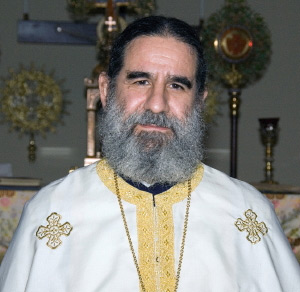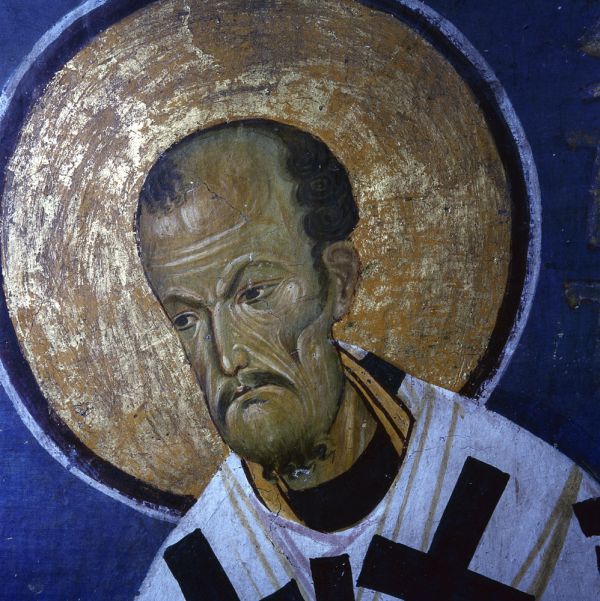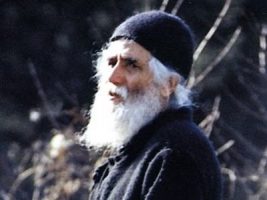This article was first published in Greek in the Journal SYNAXI, Vol 77, Jan-March 2001, pp 49-59.
Monasticism or Marriage? This is a perennial question facing many Orthodox Christians throughout the centuries. Nowadays, two answers are usually presented to this question and the proponents of both hold that they both represent Patristic Tradition. On the one side, we have the claim that monasticism is superior to marriage because it is the only way to perfection. On the other side, we have the claim that marriage can also lead to the ultimate state of theosis. Both parties turn to the Patristic witness to support their claim. The first group points primarily to monastic writings (most of which were written for monks), where they find an exultation of the monastic life at the expense of marriage. The others search further and conclude, that the fathers in general had a deep respect of the married state and thought of it as equal to monasticism, but are still faced with the many texts which consider marriage inferior.
The first position, which elevates the monastic life above the married state, creates serious theological and anthropological problems: If God Himself created humanity as male and female and ordained that the two become one body in marriage, procreate and struggle within human society, and since it is not easy for everyone to live the monastic life, but rather it seems more natural for men and women to fall in love, come together and depend on each other in this community of love, how can this way of life given by God from the beginning be inferior. When God created Eve from the side of Adam, He did not send them out to live alone separate from each other, but rather commanded them to become again “one flesh.”[1] If monasticism was the better route to His Kingdom, why didn’t God leave Adam alone in Paradise to exercise this ascesis of monachism? Is it possible that, the creation of the woman and the planting in them of this attraction between the two, may have a higher purpose than the pleasure of the flesh or even procreation itself? For answers to these questions a careful and in depth examination of the Patristic texts is necessary.
Usually, those seeking to present the higher status of the life of virginity as compared to the married life, turn to the great Father of the Church, St. John Chrysostom and most specifically to his works, “On Virginity”, “To Theodore the Monk”, “On the avoidance of Fornication” and “Concerning One marriage.” In these four works they find ample evidence to support their position. Is, however, the examination of these texts enough for a conclusive estimation of Chrysostom’s understanding on the issue? Is it really true that he went through life considering marriage inferior to monasticism?
In the present study, I attempted to examine the writings of St. John in chronological order with the purpose of identifying a possible development in his thought with regard to marriage. The works mentioned above were written by him during the first period of his ministry. Some of these were written between 372-380 AD while he lived as a hermit outside of Antioch, and the others were written between 381-385 AD, while he served as a deacon in Antioch, before he immersed himself in pastoral work and experienced firsthand the life and spiritual struggle of married Christians in the Church.[2]
The exultation of Virginity
These early writings of St. Chrysostom are replete with rhetorical expressions and betray the fervor of the young monk, both for the austere ascetic life, which he eventually had to abandon because of his ill health, but also for the art of rhetoric, which he applies for the first time to ecclesiastical themes. At this point, it is obvious that his thought is still influenced by Greek philosophy, in which he was recently trained at the feet of his teacher Libanius, the great philosopher of that time. Many of his positions in these early works, where he considers marriage and sexual intercourse as obstacles in the effort to attain virtue, could have easily have come out of the mouth of a Stoic philosopher.
As a result, in his early works, the young ascetic John, without rejecting marriage as a human institution (or even as a way of life – since it is acceptable to God), takes a negative stance toward it (especially toward conjugal relations), and elevates virginity and the monastic life to a higher level.[3] He presents the sexual act mixis (thv mivxh) and everything related to the human life and society as a result of the fall of the first couple and the condescension of God to the weakness of humanity.[4] He presents marriage as difficult and burdensome, a yoke and slavery,[5] while the monastic life as liberation from the yoke of the secular life and this slavery. “The one concerned with the things of the Lord is higher,” he says to his friend Theodore (trying to convince him to not abandon the monastic habit)[6] because it is more difficult for the married man to enter the Kingdom of God.[7] Utilizing the rhetorical technique, the young Chrysostom speaks of marriage and the secular life as a nest where the lazier of men find refuge, and concludes:
“Those who are brave and lovers of the light leaving this lifestyle behind with great ease, they fly to the heights and gain heaven, having left behind all the things of the earth, marriage, money, worldly cares and all other things which pull us down to the earth.”[8]
In his work “In Praise of Maximus and concerning who you should take as wives” (also from the same early period of his life) he explains that, although marriage is basically good, since God blessed it, it was given, rather, as a condescension of the love of God for the weakness of man,
“so that we may avoid fornication, control our sexual desire, live with sobriety and please God by being satisfied in our own wife.”[9]
Marriage, in other words, is for the weak, those unable to control their carnal passion.
Further down, advising that the wife we choose should be of a prudent and virtuous soul, he repeats:
“Just for this one reason alone should we take a wife, so that we can avoid sin, so that we may be rid of all fornication.”[10]
In his homily “On the Avoidance of Fornication” (which was also written during the early period of his ministry), Chrysostom repeats the same idea, declaring marriage to be a “medicine against fornication,”[11] the only reason of marriage being to aid us in living with prudence. Because sexual desire entered man, God established marriage so that man may be bound to one woman so the excessive use of the sexual drive may be curtailed.[12] Marriage was also given for procreation, but it was primarily given in order to quench the flame of the carnal desire.[13] Procreation – which in the beginning was the second reason for marriage – is not necessary now, suggests the young John Chrysostom. Especially now, that the earth has been filled with people, procreation is no longer useful. Now the only reason for marriage is the containment of the carnal passions and the avoidance of sin. This opinion sets Chrysostom apart from the contemporary norm of Roman society, where a couple was obligated to bear children in order to offer new citizens to the polis.[14]
“Therefore, the reason for marriage is this only, that one may not fornicate; that is the purpose for which this medicine was established.”[15]
The life of virginity, therefore, (i.e., the life rid of conjugal relations, passions and carnal desires) and by extension the monastic life, is a higher state of existence and more beneficial to man, claims young Chrysostom. This emphasis on the issue of virginity (which he understands as the abstention from every sexual relation) is even more apparent in his advice given to couples; they are asked to live a life of continence within marriage as soon as possible and begin to live as if they are virgins. Following that, they are asked to join a monastery at some point and give up their children to be educated and be brought up by other monastics in different monasteries. In other words, Chrysostom suggests that only through monasticism will married people be able to reach perfection.
Anyone who reads these texts out of context and does not proceed to examine carefully his voluminous works from the subsequent years of his life and especially those from his more mature years, will have to come to the following two conclusions: that for Chrysostom (a) monasticism is the superior way (if not the only one) for the sanctification and perfection of man, and (b) that marriage is deficient compared to the monastic life, because its only purpose is the satisfaction of the sexual drive. Some people have even claimed, based on the above, that for Chrysostom marriage is a sort of fornication, albeit a legal one.
Marriage gains equality to Virginity
There is, nevertheless, a historical detail, which seems to be unknown to many who have dealt with this issue in the past: That these positions of St. Chrysostom, with regard to marriage, had changed over time. His work with people and experience of their struggles, but also his possible encounter with Spirit-filled and enlightened ascetic married couples during his ministry as a priest in Antioch (starting in 386 AD), forced him to reconsider and revise his understanding of the spiritual value of the married life. As a pastor, attempting to bring his flock to the Kingdom of God, he seems to have eventually concluded that marriage can lead to salvation and perfection, as well, not only monasticism. Understanding that monasticism is not for everyone, and seeing that married people are far more in numbers than the monks, the priest John could not imagine that the God of Love has ordained that the many will not be saved, or that they may have no hope for spiritual growth just because they are not able to become monks. It seems to me, that this led him to the conclusion that marriage must be equal to monasticism, at least in the effort of man for perfection. He found ample evidence in the O.T. in order to build this new thesis. In his Homily 21 on Genesis, written in 388 AD,[16] just two years after his ordination to presbyter, he speaks about Enoch, Job and other married men of the O.T. who were able to please God, and explains:
“Because, if we are prudent, neither marriage, nor the rearing of children, nor anything else will be able to prevent us from pleasing God. . . . If, then, my beloved, marriage or the rearing of children were to become an obstacle in the way to virtue, the creator of all things would not have introduced marriage into our lives, thus harming us in the important and much more necessary things.”[17]
The ascesis of prayer, which St. Paul asks for (in Col. 4:2) and the admonition of the Apostle not to be too concerned in satisfying the desires of the flesh (in Rom. 13:14), are not only for the monks, Chrysostom now says, but are also required from those who live in the cities. In addition, the Beatitudes of the Lord, were not spoken for the monks alone but are addressed to city dwellers, as well. Therefore, both those who are married, as well as the monastics, are required to fulfill the same commandments and both states lead to the same result; the attainment of virtue and enjoyment of the Kingdom of God:
“Because, if it was not possible through marriage for one to achieve those things, which the monks do, everything would have been destroyed and corrupted and virtue would have been limited only in a narrow space. . . . It is possible and very possible indeed, for us to have wives and also accomplish virtue if we want to . . . .”[18]
And even if certain married people were prevented from attaining virtue, the problem is not in marriage itself, Chrysostom explains, but it is because of their free will (proaeresis) which handled marriage inappropriately. And he advises:
“Use marriage according to the rule of good measure and you will be first in the Kingdom enjoying all the gifts of God.”[19]
At this point of his life, he saw marriage as the opportunity for people to exercise continence and prudence, not only with regard to the things of the flesh, but also with material belongings.[20] He also saw the possibility for the practice of love and philanthropy toward others and concluded that the married life is not lacking in the potential for the cultivation of the virtues.
Eros and agape (love) lead to perfection
Gradually, the position of St. Chrysostom with regard to marriage becomes even more positive. In his commentary on St. Paul’s Epistle to the Ephesians, which he wrote in 396-397 AD during the second period of his life and a short time before his election to the episcopal throne of Constantinople (Fall of 398) and while he was still serving the Church of Antioch as presbyter, he sees marriage as the opportunity for the perfection of agape (love):[21] “For God all things are secondary to agape (love),”[22] explains the now experienced priest. Echoing St. Paul, he goes on to say that love within marriage is an image of the love of Christ for the Church. Just like Christ loves the Church and sacrifices Himself for her, so also the husband must love his wife and be willing to even give his life for her. And just like the Church is obedient to Christ without been demeaned and reduced, so also the wife must be obedient to her husband for the sake of peace, concord and order, retaining, nevertheless, equality with him.[23] The eros of the husband for his wife and vise versa is “eros which resides in their nature.”[24] Eros is not evil or perverted, St. Chrysostom explains, but it is an integral part of human nature planted deep into the human soul. Eros is not a result of the Fall, or just a carnal desire, as he held in his younger years. This eros is the force, which unites the essence of man, makes it one and completes it. Eve was formed from the essence of Adam. In Adam (or in every man) is united through the force of eros the other part of the human race in order to reconstitute and complete the human being into its one essence. Because the woman was made from the side of man, now they constitute two halves.[25] In this mystery of love, the two are brought together and become one body.[26] “Behold again the mystery of agape (love),” proclaims Chrysostom. If the two do not become one, they are unable to produce another, to create many. What does this mean?
“That the power of the union is great. The innovative wisdom of God divided the one into two opposites from the beginning, and desiring to show that even after the division they are still one, He did not allow for the individual to be sufficient for the birth of children, because the individual is not the fullness of the one, but only half of the one . . . Because the woman and the man are not two anthropoi (a[nqrwpoi) but one anthropos (a[nqrwpo”).”[27]
The body comes unto its own member,[28] he explains further down. “They come together and the two create one.”[29] The product of this union is neither a soulless image, nor an image of someone on earth, but an image of God Himself and according to His likeness.[30] The conjoining “extends and mixes the bodies of both. Just as when one puts myrrh in oil he turns the two into one, so also here.”[31] Marriage is also a mixing of bodies; that is why there is a union.[32] Eros is that force which leads to this union. Great is the power of eros!
“Nothing unites so much our life as the eros between a man and a woman; for the sake of this eros many even surrender their weapons, many surrender even their own souls,”[33]
writes St. Chrysostom fifteen years after his work “On Virginity” (which was written perhaps during the time of his diaconate).[34]
This eros, he explains, cannot be only in the body but it is also in the soul. Then, the eros remains strong, “because it is eros of the beauty of the soul and not just of the body.”[35] For Chrysostom now, the three forces, which bring together the male and the female, agape, eros and filia, coexist in marriage and coincide. Together they strengthen the bond of marriage, together they unite the nature of man so that the division brought about by the Fall may be abolished and man can become one again. Together they transform the carnal union of man to a union of the souls and they in turn are made spiritual. “Great is the mystery of marriage!” exclaims Chrysostom. “Marriage is a type of the presence of Christ.”[36]
With the above words, St. John has shifted twice from his original position that marriage is only for the control of the sexual drive and the avoidance of sin. First he moved to the position that marriage is equal to the monastic life and virginity, and now he claims that it is a means by which the two parts of human nature, torn apart by the Fall, may be brought back together again into unity and that the love between man and woman may be perfected according to the image of the relationship of Christ with the Church.
St. Chrysostom does not stop here, but takes a further step away from the original positions of his youth; he sees marriage as an ascesis of the responsibility of the one for the other. Advising husbands not to seek the beauty of the body in the wife but rather the beauty of the soul, he encourages:
“Let us clean up entirely the internal spots. Let us remove the internal wrinkles. Let us eliminate the imperfections from the soul. This is the kind of beauty, which God wants. Let us prepare the woman to appear beautiful in front of God, not to us.”[37]
Marriage becomes spiritual as we offer ourselves in self-sacrifice and the effort for the perfection of the other. Thus marriage ceases to be governed by passion or the joining of the bodies, but becomes wholly spiritual, because “the soul is connected in an ineffable relationship with God.”[38] Thus, the bodily union leads eventually to the spiritual one.
Furthermore, the now mature priest John sees the conjugal union as an opportunity and a means for the spouses not only to perfect themselves personally but also to create in their home together with their children “a small church.”[39] Being transformed by their love, which has been perfected within their marriage, they are now able to move further outwards, even beyond their personal and family boundaries and touch also all those around them who may be in need. This is a major issue for St. Chrysostom who spends tremendous energy advocating for the poor and needy.
Virginity – Further development
A development in the thought of the great preacher of Christianity occurred also with regard to the concept of virginity. In his writings from the second period of his life, virginity acquires a different form and expression; it is no longer a physical condition but a spiritual one. Virginity is now the beauty of the soul; that beauty, which the Lord promised not to the unmarried women but rather to those with pure souls.[40] Commenting on the words of St. Paul in 2Cor. 11:2, he explains:
“He did not say these things to the non-married alone, but to the whole Church. Because the woman who is pure in her soul is a virgin, even if she has a husband; she is a virgin and deserves to be marveled at, because she has the true virginity. Because this one (virginity in the flesh) is an outcome and a shadow of the other one (virginity in the soul) and that one (the virginity in the soul) is the true virginity.”[41]
We will attain the virginity of the soul, he explains, if we do not allow the concerns of life to corrupt us, if we do not become attached to material things but desire the Bridegroom Christ.
In another text, he advises the husband to treat his wife with love and encourages him to confess his love to her without any fear that she may become prideful.[42] He advises them to pray together, to attend church together and after they return home to demand from each other the observance of the commandments of God, exercise of patience, frugality, modesty and decency, and concludes:
“If someone marries a wife in this way, and he is no less prudent in these things than the monastics, then he will not be inferior to the monastics who are not married.”[43]
If married people, then, where to live in this way, i.e., in the ascesis of prayer, obedience to God and the ascesis of love toward their spouse, children and the poor, not only would they become virgins, but they will even surpass the monks and the virgins in virtue![44]
Conclusions
In spite the fact that St. John Chrysostom began his writing carrier as a young monk and deacon proposing the superiority of monasticism and virginity Vs marriage using a rhetorical style reminiscent of his Stoic teacher Libanius, gradually over time, and especially during the second period of his life as a presbyter in Antioch, he modified his positions, enlightened now by a deeper understanding of the Christian theology of marriage, but also because of the maturing of his thought as he served and guided people. He arrived eventually to a view of marriage different from his early years, no longer seeing marriage as a medicine against fornication, nor as an obstacle to the perfection of man, but rather as equal to monasticism in the effort of man to please God and cultivate the virtues.
A little while later, during his last years in Antioch and before his election to the episcopal throne of Constantinople, he saw marriage as a Christian community of love and an arena and opportunity within which love can be perfected according to the image of the love of Christ for the Church. He saw eros as the innate natural force, which unites the two separated parts in humanity. Through the conjugal love and commitment, which in the end should become philanthropy for those around them, he saw the opportunity for an ascetic kind of life within marriage, which leads to perfection and opens the gate to the Kingdom of God. He also saw the exercise of the responsibility for the salvation and perfection of the other.
Chrysostom, over time, changed also his view of virginity. He abandoned his original concept of virginity as a physical bodily state and opted for an understanding of virginity as a higher state of existence; virginity is the spiritual purity of the soul, which can be attained both by monks and married people alike.
To the question whether monasticism is superior to marriage, I think that the mature theologian and pastor Chrysostom would have answered like this: “Monasticism and marriage are two different ways of life both leading to the Kingdom of God those who live their lives in the ascesis of love, struggling for the purity of their souls and detachment from the things of the world, desiring and seeking union with the Bridegroom Christ.”
After the above analysis, it becomes clear that St. John Chrysostom was finally able to offer an ascetic theology of marriage, where the married state becomes a field of ascesis for the attainment of the virtues and most especially the perfection of agape (love). This love is built first between the spouses, then extends toward the children and other domestics and finally moves further outwards to embrace and comfort the poor and suffering in the society. Within this ascetic context, eros and sexual attraction are transformed to positive forces for the perfection of the people involved. With this kind of theology of marriage, Chrysostom not only went against the norm of Roman society by claiming that procreation is no longer a necessary goal of marriage, but he also sought to replace the ancient Roman understanding of the household (domus) as the economic and societal unit, by a spiritual, purely Christian one, based on the prototype of the love of Christ for man. Furthermore, Chrysostom set out to convert the Roman domus into a Christian asketerion, and even better into a “small church” (Ecclesian mikran).
[1] St. Chrysostom emphasizes that God did not create the woman from a different kind of nature so that she may not come to man as “other” (foreign/different).
[2] The existential experience of life is one of the fundamental reasons for which the Church has had married priests; they come out of the community in which they are immersed in the same life as their parishioners. The married state of life is not considered as an impediment to their personal sanctification or the sanctification of their flock.
[3] “Concerning One marriage” 2, EPE 30, 55.
[4] “On Virginity” 15, 2, EPE (Greek Fathers of the Church, in Greek) 29, 496.
[5] Ibid., 41, EPE 29, 579-580; Also “To Theodore the Monk”, 5, EPE 28, 737-738.
[6] “To Theodore the Monk”, 5, EPE 28, 741.
[7] See also “On Virginity”, 44, EPE 29, 591-592, where he claims that it is easier to attain the Kingdom of God through virginity rather than through marriage.
[8] “On Virginity”, 17, 2, EPE 29, 500.
[9] “In Praise of Maximus . . .”, 5, EPE 27, 181. See also “Concerning One Marriage”, 3, EPE 30, 63, where he sees the allowance of a second marriage by St. Paul as a condescension to the weakness of man. This weakness, claims Chrysostom is not because of lack of strength, but rather because of the “lack of strength of the human will”.
[10] “In Praise of Maximus . . .”, 5, EPE 27, 181.
[11] “On the Avoidance of Fornication”, 2, EPE 27, 98.
[12] Ibid., 107-109.
[13] “On Virginity”, 19, 1-2 EPE 29, 504-506; PG 48 547.
[14] See Peter Brown, The Body and Society: Men, Women, and Sexual Renunciation in Early Christianity, Columbia University Press, New York 1988, 307-308.
[15] “On the Avoidance of Fornication”, 3, EPE 27, 109; PG 51, 213. Since people did not yet have the hope of the resurrection, God gave comfort to people through children, so that they may leave behind living images of themselves and the human race may continue on.
[16] Johannes Quasten, Patrology, Vol. III, The Golden Age of Greek Patristic Literature from the Council of Nicea to the Council of Chalcedon. Westminster, Maryland: Newman Press, 1960, 434.
[17] Homily 21, 5, On Genesis, EPE 2, 621-623; PG 53, 180d. See also Homily 55, 6, On Matthew, EPE 11, 238-240; PG 58, 548-549, and Homily 4, 2, 3 On Isaiah, EPE 8A, 388-390; PG 56, 122-123; also Homily 6, 1, On Isaiah, EPE 8A, 426; PG 56, 136.
[18] Homily 7, 4, On Hebrews, EPE 24, 393-394; PG 63, 68. This homily was written during the last year of his episcopal ministry in Constantinople in 403 or 404 (see Quasten, Patrology, vol. III, p. 450) and confirms his position introduced during his ministry as a priest in Antioch.
[19] Homily 7, 4, On Hebrews, EPE 24, 394; PG 63, 68.
[20] Ibid. Cf. 1Cor 7:29-31.
[21] Homily 20, 1, On Ephesians, EPE 21.
[22] Homily 34, 3, On 1Corinthians, EPE 18A, 427. The homilies on 1Cor have to be from his time in Antioch, although we are not certain about their exact date (Quasten, Patrology, vol. III, p. 445). It seems, however, from his position on marriage that they have to be from the second period when he was a priest. Panagiotis Christou in his Patrologia, Vol 4, 285, believes that “These homilies were certainly delivered in Antioch in 395.”
[23] Homily 20, 1, On Ephesians, EPE 21, 197-199. See also EPE 21, 4, 215. See also Homily 34, 3, on 1Corinthians EPE 18A, 427-429, where St. Chrysostom has equated the “desire” of the man for his wife with agape (love). The desire of the man (which is stronger) serves the purpose of subjugating the man to his wife in order to preserve the equality of the two. Also, the fact that childbearing is not depended only on the one helps preserve the balance between the two genders. See also “Concerning One marriage” 3, EPE 30, 67.
[24] Homily 20, 1, On Ephesians, EPE 21, 194.
[25] Homily 12, 4, On Colossians, EPE 22, 345 (The homilies on Colossians were written in the year 399 in Constantinople, Quasten, Patrology, vol. III, 448).
[26] Homily 12, 4, On Colossians, EPE 22, 343
[27] Ibid.
[28] Ibid., 345.
[29] Ibid., 343.
[30] Ibid.
[31] Ibid., 345
[32] Homily 19, 3, On 1Corinthians, EPE 18, 531
[33] Homily 20, 1, On Ephesians, EPE 21, 195.
[34] See Chrysostomos Baur, John Chrysostom and his time, transl. by M. Gonzaga, Westminster, Maryland: The Newman Press, 1959; reprint ed., 4 vols. Büchervertriebsanstalt, 1988, volume one, part one, 164.
[35] Homily 20, 2, On Ephesians, EPE 21, 205. See also Homily 56, 1 On Genesis, EPE 4, 411, where the desire of the one for the other is the power which holds marriage intact.
[36] Homily 12, 5, On Colossians, EPE 22, 347: Through his presence at the marriage, Christ “will transform the attraction, the weak and cold desire and make it spiritual. This is the meaning of the change of water into wine.” (Ibid., page 349)
[37] Homily 20, 3, On Ephesians, EPE 21, 205
[38] Homily 20, 5, On Ephesians, EPE 21, 217.
[39] Homily 20, 6, On Ephesians, EPE 21, 222, “∆Ekklhsivan mikravn”.





















